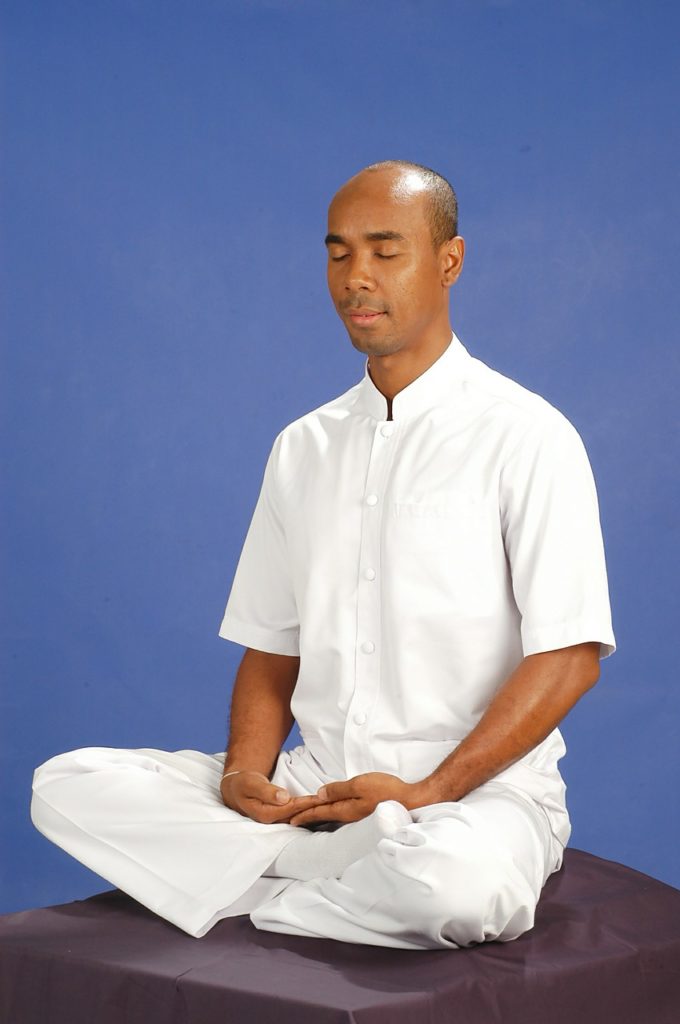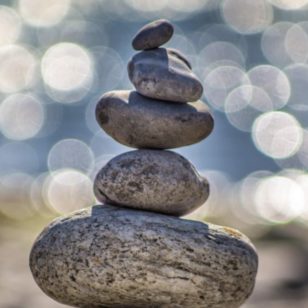So, what about posture?
Posture is important when meditating. We are aiming for a dignified and upright, yet comfortable position.
Sit with your back in an upright position, not too rigid but not too lax. You should feel comfortable, yet sense that your spinal column is straight.
After you sit, it helps to reach under each side of your derrière and pull back the fleshy parts on each side, in order to feel your two sitting bones (sitz bone, ischial tuberosity). Or you can lean forward from the waist and then raise your torso back up again. This should set you on your sitz bones. This relieves much tension in your back and is where your weight should primarily fall.
Once you have your weight properly placed, imagine that there is a string at the very top of your head pulling you upward. Your chin drops slightly to create that straight line from your head to your lumbar area.
Then relax any excess tension, so as not to be rigid or force a straight posture.
So, what do you do with your hands? The easiest thing to do is to just place your hands on your thighs. If you want to experiment with mudras, you can put your fingers in any one of the many combinations. A mudra is a position normally touching two fingers together, for example your thumb and first finger (like making the “ok” sign) and resting your hands on your lap in this position.
Each mudra has different meanings but one practical use of the mudra is to keep enough tension in your hands so that you don’t fall asleep, yet without straining. Again, just like your back, you neither want too much tension nor too much relaxation in your hands, so that you maintain both comfort and attention.
Do not hold your hands up in the air in the mudra formation like you sometimes see when people are making a caricature of meditation. That will just make you hate meditation, albeit, give you some nice shoulder muscles.
 Sitting on a cushion
Sitting on a cushion
Some people prefer to use a cushion and sit with their legs crossed. This is the classic meditation position. There are many types of meditation cushions (called a “zafu”) on the market and it is worth investing in one, since they are made for this activity. You do not need to be in a lotus position or even cross one leg onto the other if your knees cannot take it, it is enough to just place one leg inside towards your body and bend the other right in front of that leg or slightly on top of it, however it is most comfortable for you.
Make sure that your cushion raises you up high enough so as not to feel like you are straining your back, and low enough so that your legs can rest comfortably on the floor. If you feel discomfort or your knees do not reach the ground when sitting, don’t hold them up in the air. Either adjust your height or place a cushion below one or both knees so that they are at the same height and can rest completely and comfortably.
Sitting on a meditation bench
There are special benches made for meditation which are quite comfortable, since there is less strain on the legs and knees. These are placed on a flat cushion or “zafutón” to make it more comfortable. You end up in a kneeling position but the weight is carried by your backside, like in a chair. I personally prefer this method.
Sitting in a chair
This is perhaps the best choice for people with serious knee problems or any other physical limitations that do not allow you to be in the other positions. You may also just prefer it. If you decide to sit in a chair, it helps to keep both feet on the floor, and perhaps place a cushion under them, to raise your feet a bit. You want your knees to be at the same height as your hips.
Either sit towards the edge of the chair, or towards the back, yet without resting fully on the back of the chair. It also might help to place a cushion under you to raise you up and create a good angle. Try different options and choose the most comfortable one.
Lying down
You can also meditate lying down on a mat. In this case, do not cross your legs. You can either bend your knees (as if you were going to do push-ups) or stretch them out. If you bend your legs, some like to use a band or something to loosely tie your knees together so that you don’t have to strain to keep them from falling to each side. There is a greater chance of falling asleep when lying down, but this is a great position for doing a body scan meditation.
Other possibilities
If you have any type of physical difficulty, injury or impediment, adjust your posture to one that suits you.



